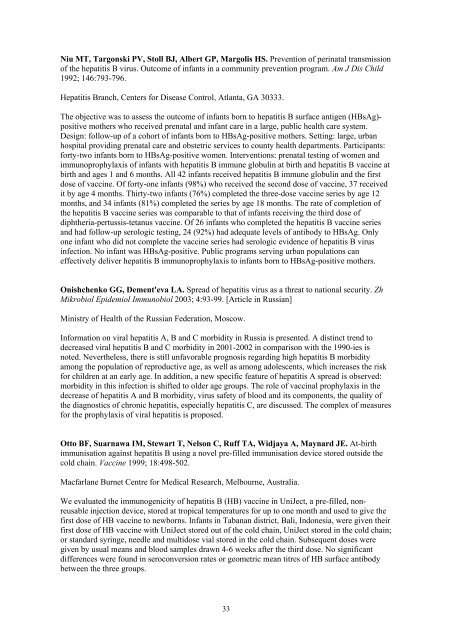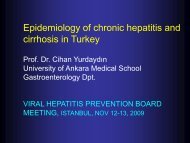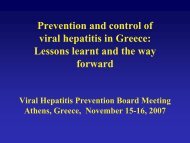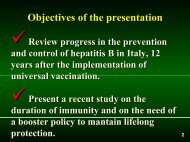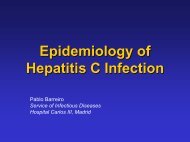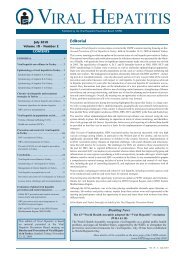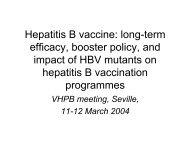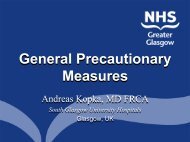Dur<strong>in</strong>g each <strong>of</strong> the <strong>in</strong>tervention phases, vacc<strong>in</strong>es were removed progressively from the st<strong>and</strong>ard 2-8 degrees C cold cha<strong>in</strong>. Freez<strong>in</strong>g temperatures were recorded <strong>in</strong> 75% <strong>of</strong> basel<strong>in</strong>e shipments. Thehighest rates <strong>of</strong> freez<strong>in</strong>g occurred dur<strong>in</strong>g transport from prov<strong>in</strong>ce to district, storage <strong>in</strong> districtlevelice-l<strong>in</strong>ed refrigerators, <strong>and</strong> storage <strong>in</strong> refrigerators <strong>in</strong> health centres. Interventions reducedfreez<strong>in</strong>g, without excessive heat exposure. Inadvertent freez<strong>in</strong>g <strong>of</strong> freeze-sensitive vacc<strong>in</strong>es iswidespread <strong>in</strong> Indonesia. Simple strategies exist to reduce freez<strong>in</strong>g - for example, selectivetransport <strong>and</strong> storage <strong>of</strong> vacc<strong>in</strong>es at ambient temperatures. The use <strong>of</strong> vacc<strong>in</strong>e vial monitorsreduces the risk associated with heat-damaged vacc<strong>in</strong>es <strong>in</strong> these scenarios. Policy changes thatallow limited storage <strong>of</strong> freeze-sensitive vacc<strong>in</strong>es at temperatures > 2-8 degrees C would enableflexible vacc<strong>in</strong>e distribution strategies that could reduce vacc<strong>in</strong>e freez<strong>in</strong>g, reduce costs, <strong>and</strong><strong>in</strong>crease capacity.Ngui SL, Andrews NJ, Underhill GS, Heptonstall J, Teo CG. Failed postnatalimmunoprophylaxis for <strong>hepatitis</strong> B: characteristics <strong>of</strong> maternal <strong>hepatitis</strong> B <strong>virus</strong> as risk factors.Cl<strong>in</strong> Infect Dis 1998; 27:100-106.Virus Reference Division, Central Public Health Laboratory, London, United K<strong>in</strong>gdom.A retrospective case-<strong>control</strong> study was conducted to determ<strong>in</strong>e why some <strong>in</strong>fants born full-termwithout obstetric <strong>in</strong>tervention to <strong>hepatitis</strong> B e antigen (HBeAg)-seropositive mothers become<strong>in</strong>fected by <strong>hepatitis</strong> B <strong>virus</strong> (HBV) despite hav<strong>in</strong>g received passive-active immunoprophylaxis.Cases <strong>and</strong> <strong>control</strong>s comprised 12 <strong>hepatitis</strong> B surface antigen (HBsAg)-seropositive <strong>in</strong>fants <strong>and</strong> 22HBsAg-seronegative <strong>in</strong>fants, respectively. Infants <strong>in</strong>fected by putative vacc<strong>in</strong>e-escape mutantswere excluded. Risk factors, after adjustment for the level <strong>of</strong> maternal viremia, were the follow<strong>in</strong>gallelic base changes <strong>in</strong> maternal HBV:C158, A328, G365, <strong>and</strong> A479 (P = 0.017, 0.005, 0.003, <strong>and</strong>0.005, respectively). High-level maternal viremia (i.e., > or = 10(8) genome equivalents/mL) was asignificant factor only after adjustment for G365 (P = 0.027). HBV DNA sequences recoveredfrom one <strong>of</strong> the cases, the case's mother, <strong>and</strong> three <strong>in</strong>fected contacts all had the high-riskmutations. Specific allelic mutations <strong>in</strong> maternal HBV <strong>and</strong> level <strong>of</strong> maternal viremia are potentialpredictors <strong>of</strong> vertical breakthrough <strong>in</strong>fection.Niesert S, Messner U, Tillmann HL, Gunter HH, Schneider J, Manns MP. Prevalence <strong>of</strong><strong>hepatitis</strong> B <strong>in</strong> pregnancy <strong>and</strong> selective screen<strong>in</strong>g. Geburtshilfe Frauenheilkd 1996; 56:283-286.[Article <strong>in</strong> German]Zentrum Frauenkl<strong>in</strong>ik der Mediz<strong>in</strong>ischen Hochschule Hannover.Infants <strong>of</strong> mothers positive for HBsAg are at risk for peripartal <strong>transmission</strong> <strong>of</strong> <strong>hepatitis</strong> B<strong>in</strong>fection. Active <strong>and</strong> passive immunisation adm<strong>in</strong>istered immediately after birth can preventneonatal <strong>hepatitis</strong> B. In a prospective study the prevalence <strong>of</strong> <strong>hepatitis</strong> B <strong>in</strong> pregnant women <strong>and</strong>the efficiency <strong>of</strong> selective antepartal screen<strong>in</strong>g <strong>of</strong> women with identifiable risk factors for <strong>hepatitis</strong>B were analysed. From November 1992 to May 1994, 912 women present<strong>in</strong>g at the department <strong>of</strong>obstetrics <strong>and</strong> gynaecology <strong>of</strong> the Mediz<strong>in</strong>ischen Hochschule Hannover were tested for HBsAg,HBeAg, anti HBs, anti HBc, <strong>and</strong> HBV-DNA. Venous blood samples were taken dur<strong>in</strong>g the thirdtrimester <strong>of</strong> pregnancy or immediately post partum. 13 (1.4%) patients were found to be HBsAgpositive. The prevalence <strong>of</strong> HBsAg <strong>in</strong> German females <strong>and</strong> women from countries with lowendemia for <strong>hepatitis</strong> B was 0.38% versus 5.7% for women from endemic areas. HBeAg wasdetected <strong>in</strong> two patients. 10 patients with a positive serological result belonged to groupsconsidered to be <strong>of</strong> <strong>in</strong>creased risk for <strong>hepatitis</strong> B <strong>in</strong>fection. Nevertheless, 6 <strong>of</strong> these women had notundergone antepartal screen<strong>in</strong>g. These f<strong>in</strong>d<strong>in</strong>gs support a need for rout<strong>in</strong>e screen<strong>in</strong>g <strong>of</strong> all pregnantwomen for HBsAg, as it has been recently <strong>in</strong>troduced <strong>in</strong> Germany.32
Niu MT, Targonski PV, Stoll BJ, Albert GP, Margolis HS. <strong>Prevention</strong> <strong>of</strong> <strong>per<strong>in</strong>atal</strong> <strong>transmission</strong><strong>of</strong> the <strong>hepatitis</strong> B <strong>virus</strong>. Outcome <strong>of</strong> <strong>in</strong>fants <strong>in</strong> a community prevention program. Am J Dis Child1992; 146:793-796.Hepatitis Branch, Centers for Disease Control, Atlanta, GA 30333.The objective was to assess the outcome <strong>of</strong> <strong>in</strong>fants born to <strong>hepatitis</strong> B surface antigen (HBsAg)-positive mothers who received prenatal <strong>and</strong> <strong>in</strong>fant care <strong>in</strong> a large, public health care system.Design: follow-up <strong>of</strong> a cohort <strong>of</strong> <strong>in</strong>fants born to HBsAg-positive mothers. Sett<strong>in</strong>g: large, urbanhospital provid<strong>in</strong>g prenatal care <strong>and</strong> obstetric services to county health departments. Participants:forty-two <strong>in</strong>fants born to HBsAg-positive women. Interventions: prenatal test<strong>in</strong>g <strong>of</strong> women <strong>and</strong>immunoprophylaxis <strong>of</strong> <strong>in</strong>fants with <strong>hepatitis</strong> B immune globul<strong>in</strong> at birth <strong>and</strong> <strong>hepatitis</strong> B vacc<strong>in</strong>e atbirth <strong>and</strong> ages 1 <strong>and</strong> 6 months. All 42 <strong>in</strong>fants received <strong>hepatitis</strong> B immune globul<strong>in</strong> <strong>and</strong> the firstdose <strong>of</strong> vacc<strong>in</strong>e. Of forty-one <strong>in</strong>fants (98%) who received the second dose <strong>of</strong> vacc<strong>in</strong>e, 37 receivedit by age 4 months. Thirty-two <strong>in</strong>fants (76%) completed the three-dose vacc<strong>in</strong>e series by age 12months, <strong>and</strong> 34 <strong>in</strong>fants (81%) completed the series by age 18 months. The rate <strong>of</strong> completion <strong>of</strong>the <strong>hepatitis</strong> B vacc<strong>in</strong>e series was comparable to that <strong>of</strong> <strong>in</strong>fants receiv<strong>in</strong>g the third dose <strong>of</strong>diphtheria-pertussis-tetanus vacc<strong>in</strong>e. Of 26 <strong>in</strong>fants who completed the <strong>hepatitis</strong> B vacc<strong>in</strong>e series<strong>and</strong> had follow-up serologic test<strong>in</strong>g, 24 (92%) had adequate levels <strong>of</strong> antibody to HBsAg. Onlyone <strong>in</strong>fant who did not complete the vacc<strong>in</strong>e series had serologic evidence <strong>of</strong> <strong>hepatitis</strong> B <strong>virus</strong><strong>in</strong>fection. No <strong>in</strong>fant was HBsAg-positive. Public programs serv<strong>in</strong>g urban populations caneffectively deliver <strong>hepatitis</strong> B immunoprophylaxis to <strong>in</strong>fants born to HBsAg-positive mothers.Onishchenko GG, Dement'eva LA. Spread <strong>of</strong> <strong>hepatitis</strong> <strong>virus</strong> as a threat to national security. ZhMikrobiol Epidemiol Immunobiol 2003; 4:93-99. [Article <strong>in</strong> Russian]M<strong>in</strong>istry <strong>of</strong> Health <strong>of</strong> the Russian Federation, Moscow.Information on viral <strong>hepatitis</strong> A, B <strong>and</strong> C morbidity <strong>in</strong> Russia is presented. A dist<strong>in</strong>ct trend todecreased viral <strong>hepatitis</strong> B <strong>and</strong> C morbidity <strong>in</strong> 2001-2002 <strong>in</strong> comparison with the 1990-ies isnoted. Nevertheless, there is still unfavorable prognosis regard<strong>in</strong>g high <strong>hepatitis</strong> B morbidityamong the population <strong>of</strong> reproductive age, as well as among adolescents, which <strong>in</strong>creases the riskfor children at an early age. In addition, a new specific feature <strong>of</strong> <strong>hepatitis</strong> A spread is observed:morbidity <strong>in</strong> this <strong>in</strong>fection is shifted to older age groups. The role <strong>of</strong> vacc<strong>in</strong>al prophylaxis <strong>in</strong> thedecrease <strong>of</strong> <strong>hepatitis</strong> A <strong>and</strong> B morbidity, <strong>virus</strong> safety <strong>of</strong> blood <strong>and</strong> its components, the quality <strong>of</strong>the diagnostics <strong>of</strong> chronic <strong>hepatitis</strong>, especially <strong>hepatitis</strong> C, are discussed. The complex <strong>of</strong> measuresfor the prophylaxis <strong>of</strong> viral <strong>hepatitis</strong> is proposed.Otto BF, Suarnawa IM, Stewart T, Nelson C, Ruff TA, Widjaya A, Maynard JE. At-birthimmunisation aga<strong>in</strong>st <strong>hepatitis</strong> B us<strong>in</strong>g a novel pre-filled immunisation device stored outside thecold cha<strong>in</strong>. Vacc<strong>in</strong>e 1999; 18:498-502.Macfarlane Burnet Centre for Medical Research, Melbourne, Australia.We evaluated the immunogenicity <strong>of</strong> <strong>hepatitis</strong> B (HB) vacc<strong>in</strong>e <strong>in</strong> UniJect, a pre-filled, nonreusable<strong>in</strong>jection device, stored at tropical temperatures for up to one month <strong>and</strong> used to give thefirst dose <strong>of</strong> HB vacc<strong>in</strong>e to newborns. Infants <strong>in</strong> Tabanan district, Bali, Indonesia, were given theirfirst dose <strong>of</strong> HB vacc<strong>in</strong>e with UniJect stored out <strong>of</strong> the cold cha<strong>in</strong>, UniJect stored <strong>in</strong> the cold cha<strong>in</strong>;or st<strong>and</strong>ard syr<strong>in</strong>ge, needle <strong>and</strong> multidose vial stored <strong>in</strong> the cold cha<strong>in</strong>. Subsequent doses weregiven by usual means <strong>and</strong> blood samples drawn 4-6 weeks after the third dose. No significantdifferences were found <strong>in</strong> seroconversion rates or geometric mean titres <strong>of</strong> HB surface antibodybetween the three groups.33
- Page 1 and 2: Pre-meeting documentPrevention and
- Page 3 and 4: Part I Prevention and control of pe
- Page 5 and 6: prevalence was significantly higher
- Page 7 and 8: clusters (obstetrics wards/hospital
- Page 9 and 10: Boxall E. Screening of pregnant wom
- Page 11 and 12: Chang MH, Hsu HY, Huang LM, Lee PI,
- Page 13 and 14: of infection in infants and childre
- Page 15 and 16: Eriksen EM, Perlman JA, Miller A, M
- Page 17 and 18: liver enzyme abnormalities than wer
- Page 19 and 20: health care, is feasible and achiev
- Page 21 and 22: HBsAg and anti-HBs in 4.5%. In the
- Page 23 and 24: immunoprophylaxis. Reflecting effec
- Page 25 and 26: Levin CE, Nelson CM, Widjaya A, Mon
- Page 27 and 28: Delaying vaccination of premature i
- Page 29 and 30: diagnosis. In the past, the inciden
- Page 31: shows that the prevalence of HBV in
- Page 35 and 36: Ranger-Rogez S, Alain S, Denis F. H
- Page 37 and 38: vaccinees) and low reactogenicity o
- Page 39 and 40: single ELISA test is about Rs40. At
- Page 41 and 42: newborns with surface antigenemia,
- Page 43 and 44: Wang Z, Zhang J, Yang H, Li X, Wen
- Page 45 and 46: of hepatitis B vaccine. This study
- Page 47 and 48: transmission has been estimated at
- Page 49 and 50: at birth and 2 weeks after birth, f
- Page 51 and 52: Chubinishvili OV, Mikhailov MI, Sak
- Page 53 and 54: Jensen L, Heilmann C, Smith E, Want
- Page 55 and 56: Onishchenko GG. Incidence of infect
- Page 57: Zanetti A, Tanzi E, Semprini AE. He


